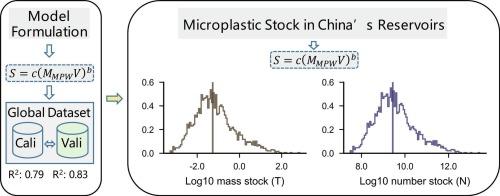基于模型的中国水库微塑料储量估算:大陆评估
IF 7.2
1区 地球科学
Q1 GEOSCIENCES, MULTIDISCIPLINARY
引用次数: 0
摘要
水库是塑料从陆地向海洋运输的重要载体和塑料的长期汇,其中微塑料的积累对淡水生态系统构成潜在风险。尽管公众对水库微塑料污染的关注日益增加,但由于微塑料采样和分析需要大量劳动力,以及现有微塑料数据之间的数据不可比较性,对水库微塑料存量进行大规模评估,以制定有效的缓解措施,仍然具有挑战性。为了解决这一差距,本文介绍了一种基于水库特定流域塑料废物地理分布和水库特征的建模方法,以估计淡水水库中的微塑料存量。首先收集全球储层的微塑性数据,并根据其可靠性评分进行筛选,然后重新调整丰度至完整的微塑性连续体(1-5000 μm)。结合水库容量和流域塑料废物数据,水库微塑料存量形成模型开发的数据集,该数据集分为校准集(n = 42)和验证集(n = 49)。该模型对校准集和验证集的拟合优度分别为0.79和0.833,用于预测微塑料数量库存。对于微塑质原料,校准集和验证集的拟合优度分别为0.76和0.826。我们随后将该模型应用于估计中国水库中的微塑料存量。我们估计,中国水库地表水中存在约10(范围:2.5-24.7)千吨微塑料,其中大型水库占微塑料存量的大部分。我们的方法的适用性超越了中国水库的背景,有可能增强对全球水库塑料污染状态的理解。本文章由计算机程序翻译,如有差异,请以英文原文为准。

Model-based estimation of microplastic stock in China’s reservoirs: A continental assessment
Reservoirs act as important vectors for land-to-ocean plastic transport and long-term sinks for plastics, where the accumulation of microplastics poses potential risks to the freshwater ecosystems. Despite increasing public concern about microplastic pollution in reservoirs, it remains challenging to conduct large-scale assessments of microplastic stocks in reservoirs required for developing effective mitigation, due to the large amount of labor needed in the microplastic sampling and analysis and the data incomparability among the existing microplastic data. To address this gap, here we introduce a modeling approach based on geographically distributed plastic waste in the reservoir-specific watershed and reservoir characteristics to estimate the microplastic stock in freshwater reservoirs. Microplastic data in global reservoirs were first collected and screened based on their reliability scores, followed by realigning the abundance to the full microplastic continuum (1–5000 μm). Combined with reservoir capacity and watershed plastic waste data, the microplastic stocks in reservoirs formed the dataset for model development, which was partitioned into the calibration (n = 42) and validation (n = 49) sets. The model achieves a goodness-of-fit of 0.79 for the calibration set and 0.833 for the validation set, to predict the microplastic number stock. Regarding the microplastic mass stock, the goodness-of-fit is 0.76 and 0.826 for the calibration and validation sets, respectively. We subsequently apply this model to estimate microplastic stocks in China’s reservoirs. We estimate that ∼ 10 (range: 2.5–24.7) thousand metric tons of microplastics are present in the reservoir surface waters in China, with large-scale reservoirs accounting for the majority of microplastic stock. The applicability of our approaches goes beyond the context of reservoirs in China, potentially enhancing the understanding of the plastic pollution state in global reservoirs.
求助全文
通过发布文献求助,成功后即可免费获取论文全文。
去求助
来源期刊

Gondwana Research
地学-地球科学综合
CiteScore
12.90
自引率
6.60%
发文量
298
审稿时长
65 days
期刊介绍:
Gondwana Research (GR) is an International Journal aimed to promote high quality research publications on all topics related to solid Earth, particularly with reference to the origin and evolution of continents, continental assemblies and their resources. GR is an "all earth science" journal with no restrictions on geological time, terrane or theme and covers a wide spectrum of topics in geosciences such as geology, geomorphology, palaeontology, structure, petrology, geochemistry, stable isotopes, geochronology, economic geology, exploration geology, engineering geology, geophysics, and environmental geology among other themes, and provides an appropriate forum to integrate studies from different disciplines and different terrains. In addition to regular articles and thematic issues, the journal invites high profile state-of-the-art reviews on thrust area topics for its column, ''GR FOCUS''. Focus articles include short biographies and photographs of the authors. Short articles (within ten printed pages) for rapid publication reporting important discoveries or innovative models of global interest will be considered under the category ''GR LETTERS''.
 求助内容:
求助内容: 应助结果提醒方式:
应助结果提醒方式:


